Abstract
The outcome of endoscopic endonasal transsphenoidal surgery in 10 patients with pituitary adenomas was compared with that of traditional transnasal transsphenoidal approach (TTA) in 20 subjects. Among the 10 individuals subjected to “pure endoscopy,” 2 had a microadenoma, 1 an intrasellar macroadenoma, 4 had a macroadenoma with suprasellar expansion, 2 had a macroadenoma with supra-parasellar expansion, and 1 a residual tumor; 5 had acromegaly and 5 had a nonfunctioning adenoma (NFA). Among the patients subjected to TTA, 4 had a microadenoma, 2 had an intrasellar macroadenoma, 6 had a macroadenoma with suprasellar expansion, 4 had a macroadenoma with supra-parasellar expansion, and 4 had a residual tumor; 9 patients had acromegaly, 1 hyperprolactinemia, 1 Cushing's disease, and 9 a NFA. At the macroscopic evaluation, tumor removal was total (100%) after endoscopy in 9 patients and after TTA in 14 patients. Six months after surgery, magnetic resonance imaging (MRI) confirmed the total tumor removal in 21 of 23 patients (91.3%). Circulating growth hormone (GH) and insulin-like growth factor-I (IGF-I) significantly decreased 6 months after surgery in all 14 acromegalic patients: normalization of plasma IGF-I levels was obtained in 4 of 5 patients after the endoscopic procedure and in 4 of 9 patients after TTA. Before surgery, pituitary hormone deficiency was present in 14 out of 30 patients: pituitary function improved in 4 patients, remaining unchanged in the other 10 patients. Visual field defects were present before surgery in 4 patients, and improved in all. Early surgical results in the group of 10 patients who underwent endoscopic pituitary tumor removal were at least equivalent to those of standard TTA, with excellent postoperative course. Postsurgical hospital stay was significantly shorter (3.1 ± 0.4 vs. 6.2 ± 0.3 days, p < 0.001) after endoscopy as compared to TTA.
Full text
PDF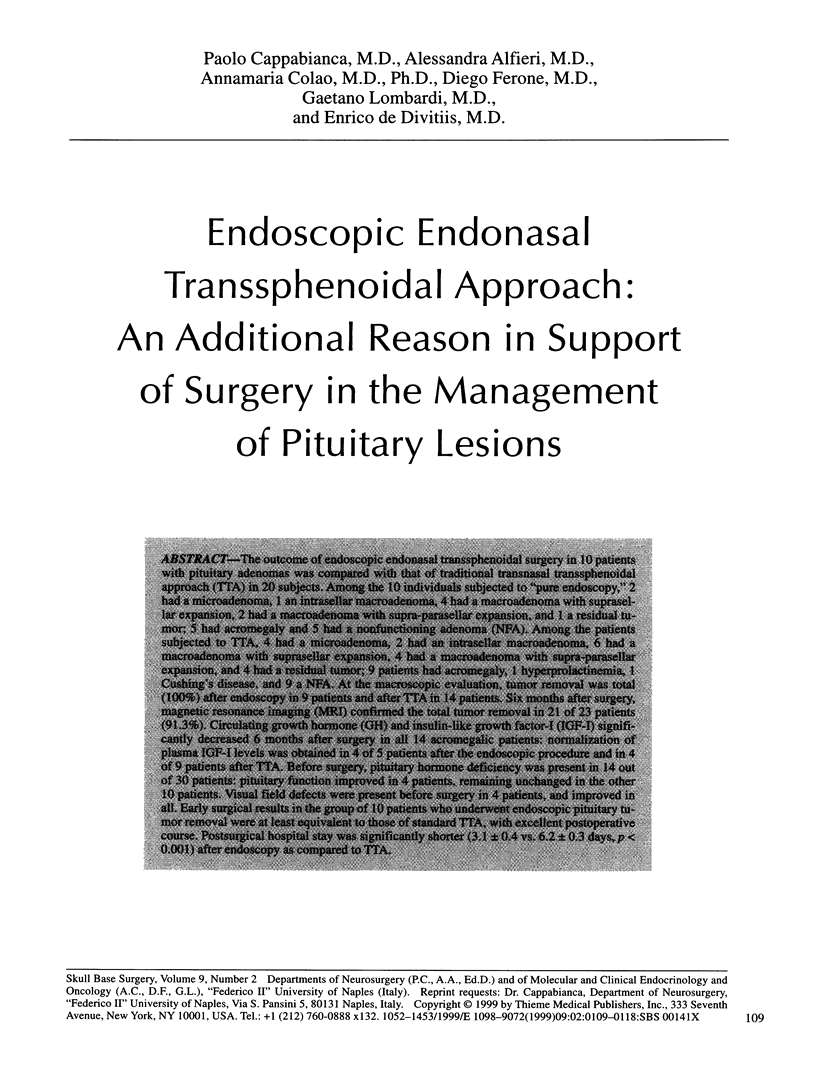
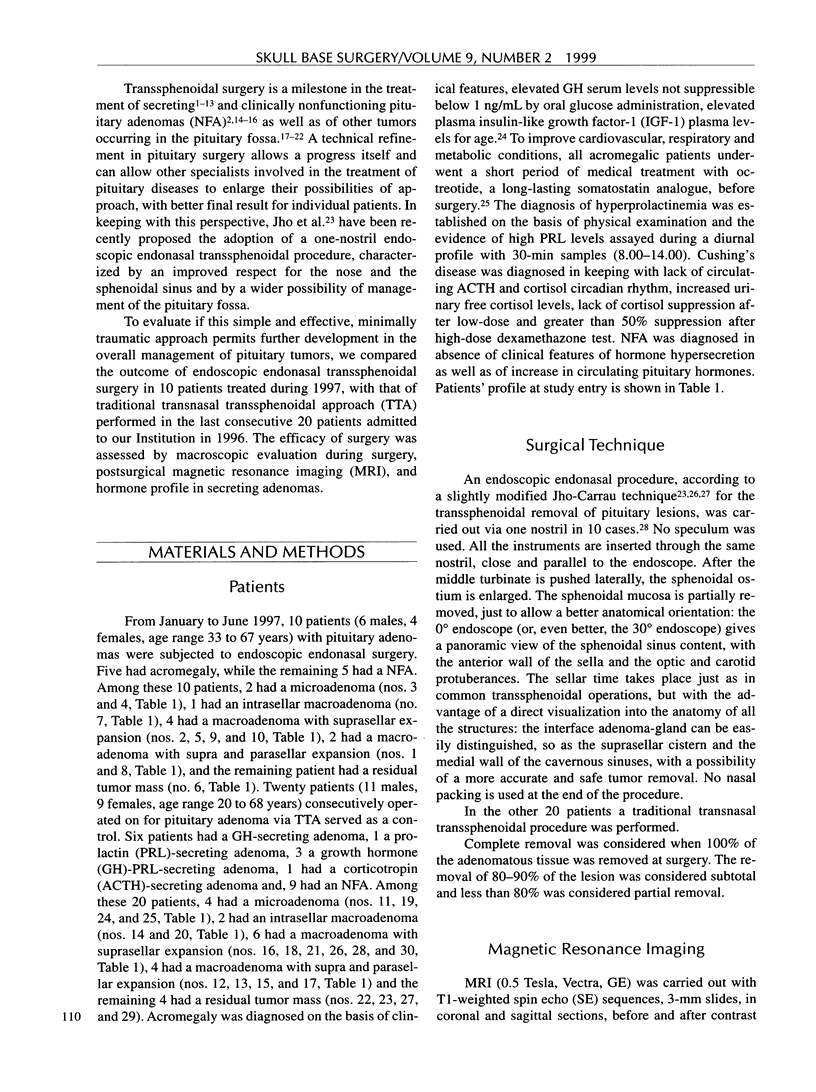
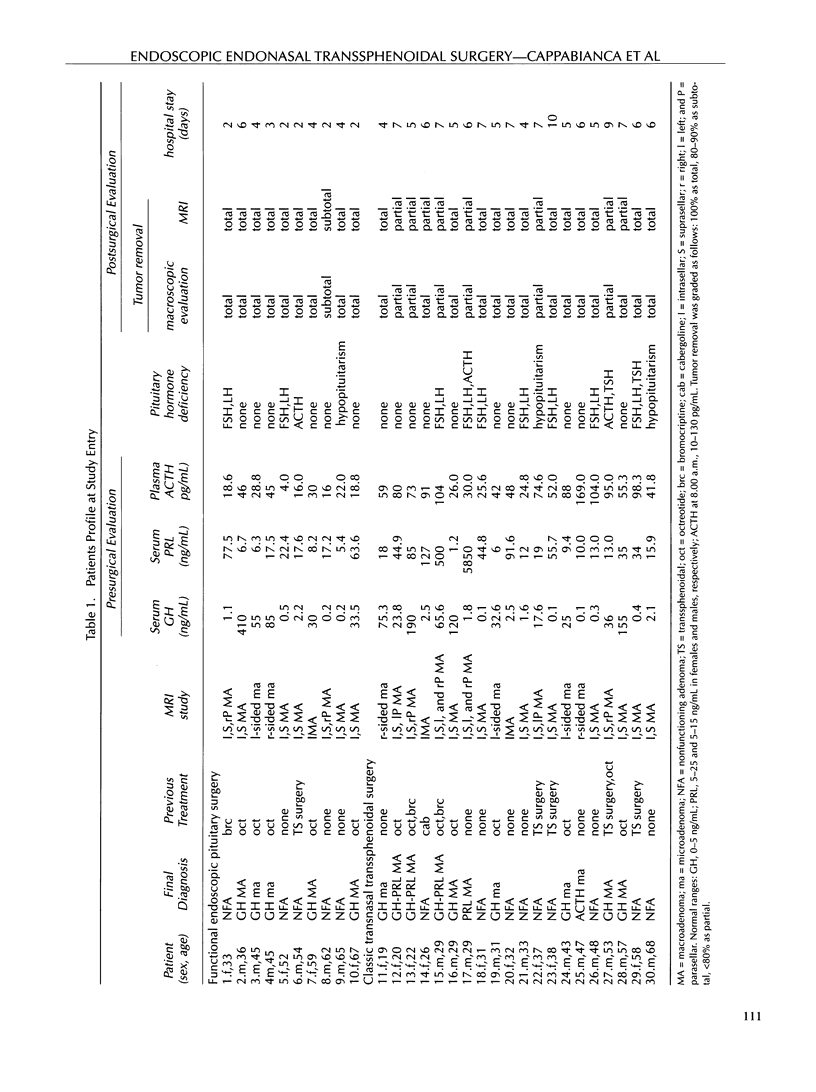
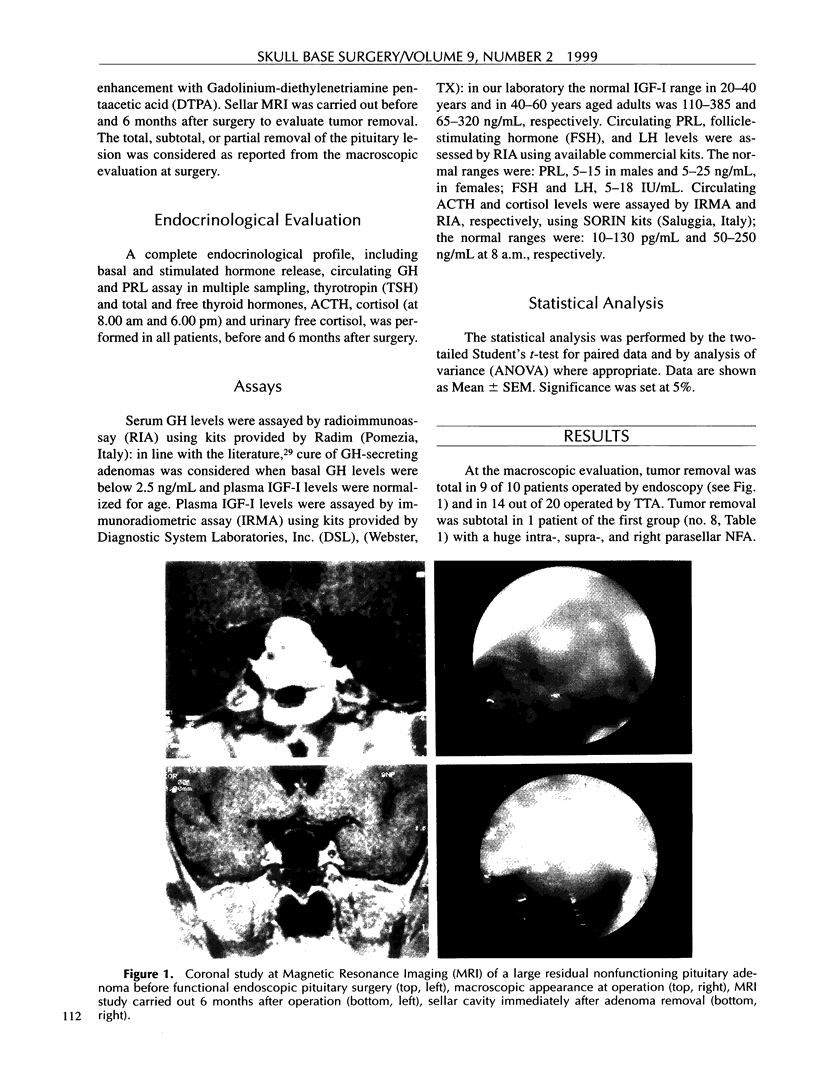
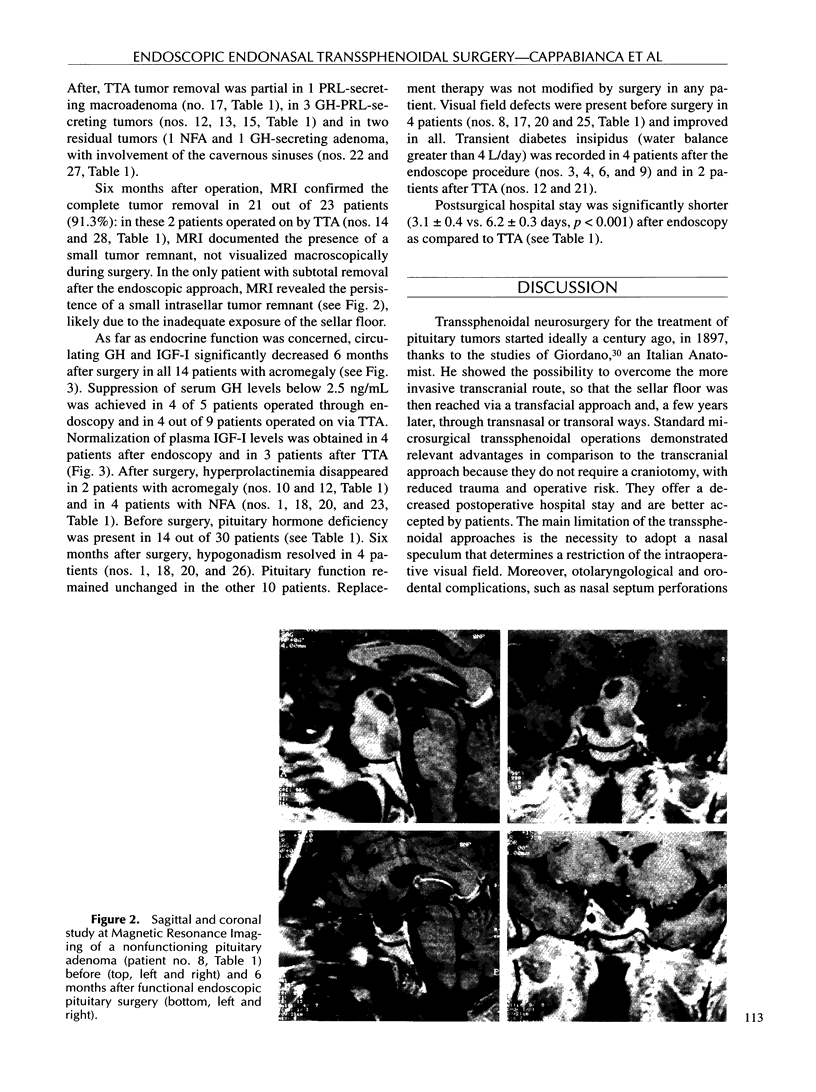


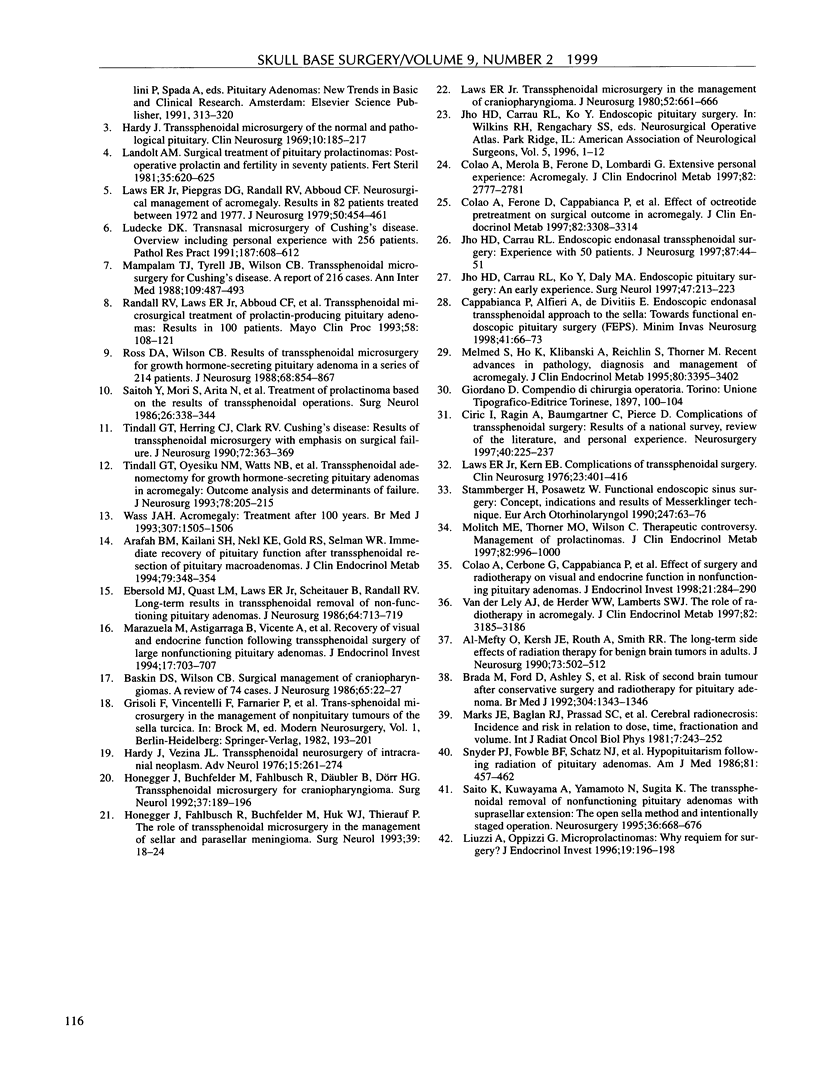

Images in this article
Selected References
These references are in PubMed. This may not be the complete list of references from this article.
- Arafah B. M., Kailani S. H., Nekl K. E., Gold R. S., Selman W. R. Immediate recovery of pituitary function after transsphenoidal resection of pituitary macroadenomas. J Clin Endocrinol Metab. 1994 Aug;79(2):348–354. doi: 10.1210/jcem.79.2.8045946. [DOI] [PubMed] [Google Scholar]
- Baskin D. S., Wilson C. B. Surgical management of craniopharyngiomas. A review of 74 cases. J Neurosurg. 1986 Jul;65(1):22–27. doi: 10.3171/jns.1986.65.1.0022. [DOI] [PubMed] [Google Scholar]
- Brada M., Ford D., Ashley S., Bliss J. M., Crowley S., Mason M., Rajan B., Traish D. Risk of second brain tumour after conservative surgery and radiotherapy for pituitary adenoma. BMJ. 1992 May 23;304(6838):1343–1346. doi: 10.1136/bmj.304.6838.1343. [DOI] [PMC free article] [PubMed] [Google Scholar]
- Cappabianca P., Alfieri A., de Divitiis E. Endoscopic endonasal transsphenoidal approach to the sella: towards functional endoscopic pituitary surgery (FEPS). Minim Invasive Neurosurg. 1998 Jun;41(2):66–73. doi: 10.1055/s-2008-1052019. [DOI] [PubMed] [Google Scholar]
- Ciric I., Ragin A., Baumgartner C., Pierce D. Complications of transsphenoidal surgery: results of a national survey, review of the literature, and personal experience. Neurosurgery. 1997 Feb;40(2):225–237. doi: 10.1097/00006123-199702000-00001. [DOI] [PubMed] [Google Scholar]
- Colao A., Cerbone G., Cappabianca P., Ferone D., Alfieri A., Di Salle F., Faggiano A., Merola B., de Divitiis E., Lombardi G. Effect of surgery and radiotherapy on visual and endocrine function in nonfunctioning pituitary adenomas. J Endocrinol Invest. 1998 May;21(5):284–290. doi: 10.1007/BF03350330. [DOI] [PubMed] [Google Scholar]
- Colao A., Ferone D., Cappabianca P., del Basso De Caro M. L., Marzullo P., Monticelli A., Alfieri A., Merola B., Calì A., de Divitiis E. Effect of octreotide pretreatment on surgical outcome in acromegaly. J Clin Endocrinol Metab. 1997 Oct;82(10):3308–3314. doi: 10.1210/jcem.82.10.4283. [DOI] [PubMed] [Google Scholar]
- Colao A., Merola B., Ferone D., Lombardi G. Acromegaly. J Clin Endocrinol Metab. 1997 Sep;82(9):2777–2781. doi: 10.1210/jcem.82.9.4257. [DOI] [PubMed] [Google Scholar]
- Ebersold M. J., Quast L. M., Laws E. R., Jr, Scheithauer B., Randall R. V. Long-term results in transsphenoidal removal of nonfunctioning pituitary adenomas. J Neurosurg. 1986 May;64(5):713–719. doi: 10.3171/jns.1986.64.5.0713. [DOI] [PubMed] [Google Scholar]
- Fahlbusch R., Honegger J., Buchfelder M. Surgical management of acromegaly. Endocrinol Metab Clin North Am. 1992 Sep;21(3):669–692. [PubMed] [Google Scholar]
- Hardy J. Transphenoidal microsurgery of the normal and pathological pituitary. Clin Neurosurg. 1969;16:185–217. doi: 10.1093/neurosurgery/16.cn_suppl_1.185. [DOI] [PubMed] [Google Scholar]
- Hardy J., Vezina J. L. Transsphenoidal neurosurgery of intracranial neoplasm. Adv Neurol. 1976;15:261–273. [PubMed] [Google Scholar]
- Honegger J., Buchfelder M., Fahlbusch R., Däubler B., Dörr H. G. Transsphenoidal microsurgery for craniopharyngioma. Surg Neurol. 1992 Mar;37(3):189–196. doi: 10.1016/0090-3019(92)90229-g. [DOI] [PubMed] [Google Scholar]
- Honegger J., Fahlbusch R., Buchfelder M., Huk W. J., Thierauf P. The role of transsphenoidal microsurgery in the management of sellar and parasellar meningioma. Surg Neurol. 1993 Jan;39(1):18–24. doi: 10.1016/0090-3019(93)90104-9. [DOI] [PubMed] [Google Scholar]
- Jho H. D., Carrau R. L. Endoscopic endonasal transsphenoidal surgery: experience with 50 patients. J Neurosurg. 1997 Jul;87(1):44–51. doi: 10.3171/jns.1997.87.1.0044. [DOI] [PubMed] [Google Scholar]
- Jho H. D., Carrau R. L., Ko Y., Daly M. A. Endoscopic pituitary surgery: an early experience. Surg Neurol. 1997 Mar;47(3):213–223. doi: 10.1016/s0090-3019(96)00452-1. [DOI] [PubMed] [Google Scholar]
- Landolt A. M. Surgical treatment of pituitary prolactinomas: postoperative prolactin and fertility in seventy patients. Fertil Steril. 1981 Jun;35(6):620–625. doi: 10.1016/s0015-0282(16)45552-4. [DOI] [PubMed] [Google Scholar]
- Laws E. R., Jr, Kern E. B. Complications of trans-sphenoidal surgery. Clin Neurosurg. 1976;23:401–416. doi: 10.1093/neurosurgery/23.cn_suppl_1.401. [DOI] [PubMed] [Google Scholar]
- Laws E. R., Jr, Piepgras D. G., Randall R. V., Abboud C. F. Neurosurgical management of acromegaly. Results in 82 patients treated between 1972 and 1977. J Neurosurg. 1979 Apr;50(4):454–461. doi: 10.3171/jns.1979.50.4.0454. [DOI] [PubMed] [Google Scholar]
- Laws E. R., Jr Transsphenoidal microsurgery in the management of craniopharyngioma. J Neurosurg. 1980 May;52(5):661–666. doi: 10.3171/jns.1980.52.5.0661. [DOI] [PubMed] [Google Scholar]
- Liuzzi A., Oppizzi G. Microprolactinomas: why requiem for surgery? J Endocrinol Invest. 1996 Mar;19(3):196–198. doi: 10.1007/BF03349866. [DOI] [PubMed] [Google Scholar]
- Lüdecke D. K. Transnasal microsurgery of Cushing's disease 1990. Overview including personal experiences with 256 patients. Pathol Res Pract. 1991 Jun;187(5):608–612. doi: 10.1016/S0344-0338(11)80155-X. [DOI] [PubMed] [Google Scholar]
- Mampalam T. J., Tyrrell J. B., Wilson C. B. Transsphenoidal microsurgery for Cushing disease. A report of 216 cases. Ann Intern Med. 1988 Sep 15;109(6):487–493. doi: 10.7326/0003-4819-109-6-487. [DOI] [PubMed] [Google Scholar]
- Marazuela M., Astigarraga B., Vicente A., Estrada J., Cuerda C., García-Uría J., Lucas T. Recovery of visual and endocrine function following transsphenoidal surgery of large nonfunctioning pituitary adenomas. J Endocrinol Invest. 1994 Oct;17(9):703–707. doi: 10.1007/BF03347763. [DOI] [PubMed] [Google Scholar]
- Marks J. E., Baglan R. J., Prassad S. C., Blank W. F. Cerebral radionecrosis: incidence and risk in relation to dose, time, fractionation and volume. Int J Radiat Oncol Biol Phys. 1981 Feb;7(2):243–252. doi: 10.1016/0360-3016(81)90443-0. [DOI] [PubMed] [Google Scholar]
- Melmed S., Ho K., Klibanski A., Reichlin S., Thorner M. Clinical review 75: Recent advances in pathogenesis, diagnosis, and management of acromegaly. J Clin Endocrinol Metab. 1995 Dec;80(12):3395–3402. doi: 10.1210/jcem.80.12.8530571. [DOI] [PubMed] [Google Scholar]
- Molitch M. E., Thorner M. O., Wilson C. Management of prolactinomas. J Clin Endocrinol Metab. 1997 Apr;82(4):996–1000. doi: 10.1210/jcem.82.4.3845. [DOI] [PubMed] [Google Scholar]
- Randall R. V., Laws E. R., Jr, Abboud C. F., Ebersold M. J., Kao P. C., Scheithauer B. W. Transsphenoidal microsurgical treatment of prolactin-producing pituitary adenomas. Results in 100 patients. Mayo Clin Proc. 1983 Feb;58(2):108–121. [PubMed] [Google Scholar]
- Ross D. A., Wilson C. B. Results of transsphenoidal microsurgery for growth hormone-secreting pituitary adenoma in a series of 214 patients. J Neurosurg. 1988 Jun;68(6):854–867. doi: 10.3171/jns.1988.68.6.0854. [DOI] [PubMed] [Google Scholar]
- Saito K., Kuwayama A., Yamamoto N., Sugita K. The transsphenoidal removal of nonfunctioning pituitary adenomas with suprasellar extensions: the open sella method and intentionally staged operation. Neurosurgery. 1995 Apr;36(4):668–676. doi: 10.1227/00006123-199504000-00005. [DOI] [PubMed] [Google Scholar]
- Saitoh Y., Mori S., Arita N., Nagatani M., Hayakawa T., Koizumi K., Tanizawa O., Uozumi T., Mogami H. Treatment of prolactinoma based on the results of transsphenoidal operations. Surg Neurol. 1986 Oct;26(4):338–344. doi: 10.1016/0090-3019(86)90133-3. [DOI] [PubMed] [Google Scholar]
- Snyder P. J., Fowble B. F., Schatz N. J., Savino P. J., Gennarelli T. A. Hypopituitarism following radiation therapy of pituitary adenomas. Am J Med. 1986 Sep;81(3):457–462. doi: 10.1016/0002-9343(86)90299-8. [DOI] [PubMed] [Google Scholar]
- Stammberger H., Posawetz W. Functional endoscopic sinus surgery. Concept, indications and results of the Messerklinger technique. Eur Arch Otorhinolaryngol. 1990;247(2):63–76. doi: 10.1007/BF00183169. [DOI] [PubMed] [Google Scholar]
- Tindall G. T., Herring C. J., Clark R. V., Adams D. A., Watts N. B. Cushing's disease: results of transsphenoidal microsurgery with emphasis on surgical failures. J Neurosurg. 1990 Mar;72(3):363–369. doi: 10.3171/jns.1990.72.3.0363. [DOI] [PubMed] [Google Scholar]
- Tindall G. T., Oyesiku N. M., Watts N. B., Clark R. V., Christy J. H., Adams D. A. Transsphenoidal adenomectomy for growth hormone-secreting pituitary adenomas in acromegaly: outcome analysis and determinants of failure. J Neurosurg. 1993 Feb;78(2):205–215. doi: 10.3171/jns.1993.78.2.0205. [DOI] [PubMed] [Google Scholar]
- Wass J. A. Acromegaly: treatment after 100 years. BMJ. 1993 Dec 11;307(6918):1505–1506. doi: 10.1136/bmj.307.6918.1505. [DOI] [PMC free article] [PubMed] [Google Scholar]
- al-Mefty O., Kersh J. E., Routh A., Smith R. R. The long-term side effects of radiation therapy for benign brain tumors in adults. J Neurosurg. 1990 Oct;73(4):502–512. doi: 10.3171/jns.1990.73.4.0502. [DOI] [PubMed] [Google Scholar]
- van der Lely A. J., de Herder W. W., Lamberts S. W. The role of radiotherapy in acromegaly. J Clin Endocrinol Metab. 1997 Oct;82(10):3185–3186. doi: 10.1210/jcem.82.10.4325. [DOI] [PubMed] [Google Scholar]




